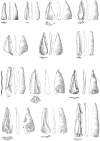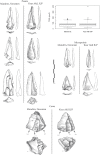The three waves: Rethinking the structure of the first Upper Paleolithic in Western Eurasia
- PMID: 37134082
- PMCID: PMC10155996
- DOI: 10.1371/journal.pone.0277444
The three waves: Rethinking the structure of the first Upper Paleolithic in Western Eurasia
Abstract
The Neronian is a lithic tradition recognized in the Middle Rhône Valley of Mediterranean France now directly linked to Homo sapiens and securely dated to 54,000 years ago (ka), pushing back the arrival of modern humans in Europe by 10 ka. This incursion of modern humans into Neandertal territory and the relationships evoked between the Neronian and the Levantine Initial Upper Paleolithic (IUP) question the validity of concepts that define the first H. sapiens migrations and the very nature of the first Upper Paleolithic in western Eurasia. Direct comparative analyses between lithic technology from Grotte Mandrin and East Mediterranean archeological sequences, especially Ksar Akil, suggest that the three key phases of the earliest Levantine Upper Paleolithic have very precise technical and chronological counterparts in Western Europe, recognized from the Rhône Valley to Franco-Cantabria. These trans-Mediterranean technical connections suggest three distinct waves of H. sapiens expansion into Europe between 55-42 ka. These elements support an original thesis on the origin, structure, and evolution of the first moments of the Upper Paleolithic in Europe tracing parallel archaeological changes in the East Mediterranean region and Europe.
Copyright: © 2023 Ludovic Slimak. This is an open access article distributed under the terms of the Creative Commons Attribution License, which permits unrestricted use, distribution, and reproduction in any medium, provided the original author and source are credited.
Conflict of interest statement
The authors have declared that no competing interests exist.
Figures









Similar articles
-
Bow-and-arrow, technology of the first modern humans in Europe 54,000 years ago at Mandrin, France.Sci Adv. 2023 Feb 22;9(8):eadd4675. doi: 10.1126/sciadv.add4675. Epub 2023 Feb 22. Sci Adv. 2023. PMID: 36812314 Free PMC article.
-
The dentition of the Early Upper Paleolithic hominins from Ksâr 'Akil, Lebanon.J Hum Evol. 2023 Mar;176:103323. doi: 10.1016/j.jhevol.2022.103323. Epub 2023 Feb 3. J Hum Evol. 2023. PMID: 36738521
-
New electron spin resonance (ESR) ages from Geißenklösterle Cave: A chronological study of the Middle and early Upper Paleolithic layers.J Hum Evol. 2019 Aug;133:133-145. doi: 10.1016/j.jhevol.2019.05.014. Epub 2019 Jul 1. J Hum Evol. 2019. PMID: 31358177
-
Vindija cave and the modern human peopling of Europe.Coll Antropol. 2006 Sep;30(3):457-66. Coll Antropol. 2006. PMID: 17058508 Review.
-
Stable isotopes show Homo sapiens dispersed into cold steppes ~45,000 years ago at Ilsenhöhle in Ranis, Germany.Nat Ecol Evol. 2024 Mar;8(3):578-588. doi: 10.1038/s41559-023-02318-z. Epub 2024 Jan 31. Nat Ecol Evol. 2024. PMID: 38297139 Free PMC article. Review.
Cited by
-
The Persian plateau served as hub for Homo sapiens after the main out of Africa dispersal.Nat Commun. 2024 Mar 25;15(1):1882. doi: 10.1038/s41467-024-46161-7. Nat Commun. 2024. PMID: 38528002 Free PMC article.
-
Long genetic and social isolation in Neanderthals before their extinction.Cell Genom. 2024 Sep 11;4(9):100593. doi: 10.1016/j.xgen.2024.100593. Cell Genom. 2024. PMID: 39265525 Free PMC article.
-
Climate amelioration, abrupt vegetation recovery, and the dispersal of Homo sapiens in Baikal Siberia.Sci Adv. 2023 Sep 22;9(38):eadi0189. doi: 10.1126/sciadv.adi0189. Epub 2023 Sep 22. Sci Adv. 2023. PMID: 37738346 Free PMC article.
-
Between land and sea: A multidisciplinary approach to understand the Early Occupation of Sicily (EOS).PLoS One. 2024 Oct 9;19(10):e0299118. doi: 10.1371/journal.pone.0299118. eCollection 2024. PLoS One. 2024. PMID: 39383127 Free PMC article.
-
The Uluzzian and Châtelperronian: No Technological Affinity in a Shared Chronological Framework.J Paleolit Archaeol. 2025;8(1):3. doi: 10.1007/s41982-024-00202-1. Epub 2025 Jan 4. J Paleolit Archaeol. 2025. PMID: 39764441 Free PMC article.
References
-
- Vandevelde S, Brochier JÉ, Desachy B, Petit C, Slimak L. Sooted concretions: A new micro-chronological tool for high temporal resolution archaeology. Quat Int. 2018;474: 103–118.
-
- Vandevelde S. Y’a pas de suie sans feu!: étude micro-chronologique des concrétions fuligineuses: étude de cas: le site paléolithique de la Grotte Mandrin (France), Thèse de Doctorat (Université Paris I—Archéologie, 2019) 640 p.
-
- Slimak L, Metz L, Teyssandier N. De la fin du Paléolithique moyen aux prémices du Paléolithique supérieur, pénombres et éclairages européens. In: Cleyet-Merle J, Shunkov MV, editors. Le troisième homme: préhistoire de l’Altaï. Paris, Réunion des Musées Nationaux; 2017. pp. 125–133.
MeSH terms
LinkOut - more resources
Full Text Sources

